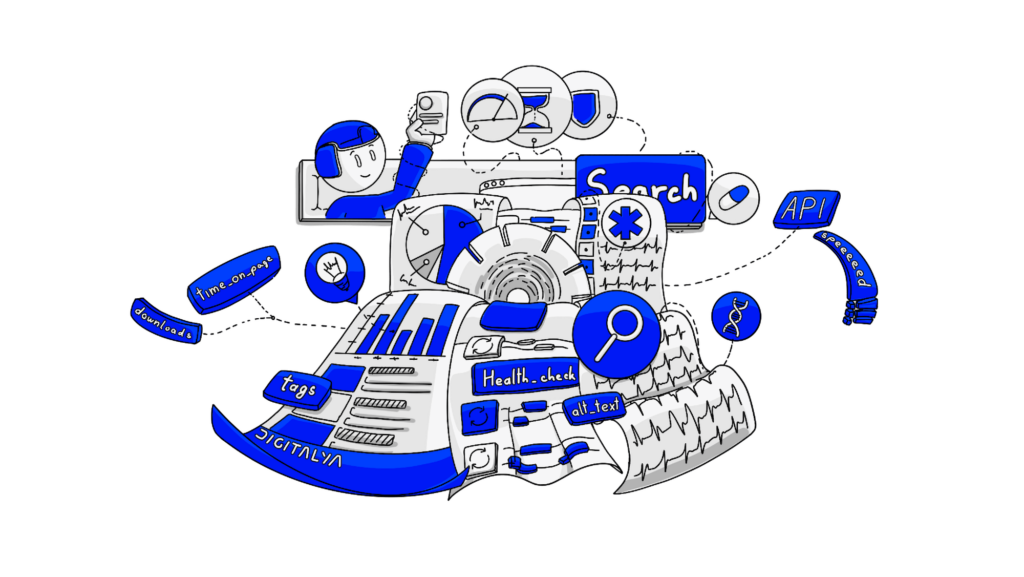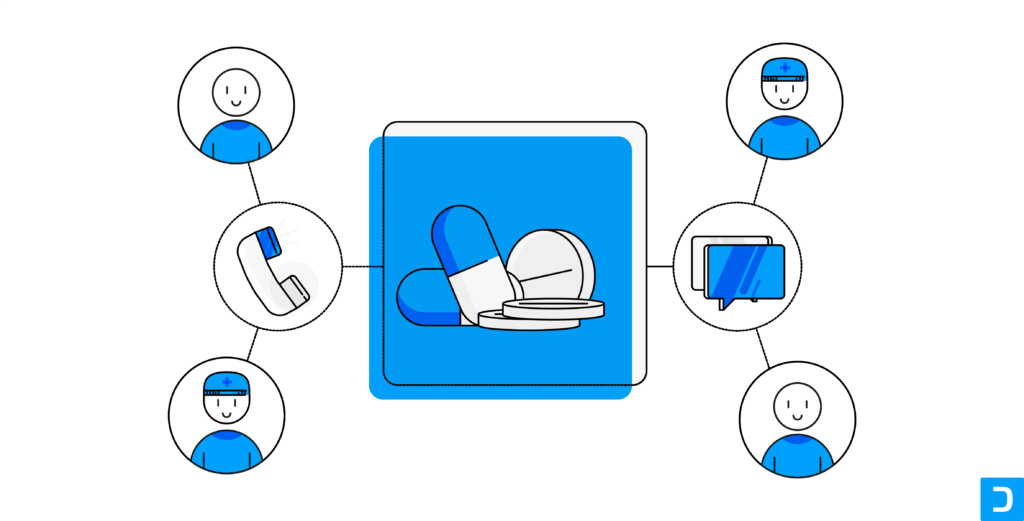HCP portals can be an excellent source for searching and finding essential knowledge such as patient treatment, advice, and medical information that helps diagnose patients and recommend treatment plans.
That being said, HCP portals have had a mixed reputation among healthcare professionals, mostly due to how they are built and maintained.
The ePharma Physician 2017 study showed that the majority of physicians, when asked about their experience with using HCP portals, noted that pharma websites were poorly organized and confusing. Add that to the low 20% credibility they attribute to pharma-provided information, and you got yourself a problem.
The good news is that others have learned the lessons the hard way, and now you can do better without repeating their mistakes.
Pharma companies have already started to change their approach and focus more on seeking out better ways to connect and engage with HCPs (healthcare professionals) by improving their content and information and offering additional methods of contact and support.
If you do things right and consider a few important factors, you can adjust the design and development of your HCP portal to fit the expectations of healthcare professionals and help them deliver better patient outcomes.
And you can be a step ahead of your competitors.
Let’s start from the beginning.
1. What are HCP portals, and why are they becoming increasingly important?
HCP portals are online tools (usually in the form of web apps and websites) that allow professionals in the healthcare industry to stay up to date with the latest information (in the form of clinical studies, research papers, clinical trials, etc.) regarding a specific area of interest.
Their functionality can expand to include other digital tools that aid HCPs (healthcare professionals), such as managing patient data and records, communicating with fellow peers and patients, and doing practice management such as appointment scheduling, billing, and more.
If you want to learn the basics, we wrote about the four main reasons HCP portals are essential for modern healthcare.
As technology advanced, HCPs started to spend many hours in front of a screen documenting how to better care for their patients.
Portals have become an important tool for physicians and other healthcare professionals in improving the outcomes of their patients, as there’s a real need for reliable sources of information that help them do a better job.
Having an HCP portal means taking advantage of the opportunity to engage with healthcare professionals, keeping an active line of communication, and sharing the data you gather through clinical research that can help people get better outcomes for their medical problems.
At the same time, building one with the wrong intentions behind it (such as prioritizing pharmaceutical marketing) or without meeting the needs of your audience can do more harm than good.
Although many HCPs see the benefit of these portals, they are trying to reduce screen time and focus more on patient interactions. Another reason HCPs avoid portals is due to challenges regarding the ease of use and navigation through the portal.
That’s your chance to build a portal that checks those boxes and becomes as helpful, intuitive, and efficient as possible for it to be effective.
This means you need to stand out from the crowd to increase engagement from HCPs and become a daily part of their activity.
Not to worry.
We’re here to guide you through the process of building an HCP portal that meets your HCP’s needs and enables better patient care.
2. Planning and research on building your own HCP portal
You can’t build a portal without first understanding who it is for, what people are looking for, their needs, and what other tools do a similar job.
By starting the process with a well-thought-out planning and research phase, you give yourself the best chances of success and lower the risk of pouring a lot of resources into something that people won’t use and your pharmaceutical company won’t benefit.
Let’s break each of them down.
2.1 Identifying the target audience and their needs
The target audience of your HCP portal typically consists of healthcare professionals, including doctors, nurses, specialists, pharmacists, and other medical personnel.
However, it is crucial to go beyond this general categorization and gain a more nuanced understanding of their specific needs, roles, and pain points.
Consider their different specializations, experience levels, and areas of interest to ensure that your portal caters to a wide range of healthcare professionals.
If necessary, select just one or a few categories of HCPs that your portal tailors to, as this allows you to provide custom digital content that meets their specific needs and expectations, which leads to an improved customer experience.
If you plan on going on a broader audience, clearly define who they are and how they might be using your portal. This way, you can uncover necessary features that appeal to specific audiences and help them in their day-to-day activity.
Most of the time, healthcare professionals aren’t doing the actual work — office managers use your tools to find specific forms or order product samples. So it would be best if you thought of all those involved and the stage where they step in.
A one-size-fits-all approach will make your portal feel generic, hard to navigate, and less valuable.
Once you identify your audience, you can research their expectations from a dedicated HCP portal. Comprehensive research is fundamental to identifying and understanding your target audience’s needs.
Here are a few practical strategies to gather valuable insights:
Surveys and interviews
You can engage with HCPs through surveys and interviews to gather firsthand information about their preferences, challenges, and expectations from an HCP portal. These interactions will provide you with invaluable qualitative data that can shape the features and functionalities of your portal and help you provide quality digital experiences.
Data analysis
Analyze existing data sources such as medical journals, research papers, industry reports, and online forums to uncover trends and insights relevant to your target audience. This approach allows you to tap into a wealth of existing knowledge and comprehensively understand the healthcare landscape.
User personas
Develop user personas that represent different segments of your target audience. These personas are fictional characters that embody your users’ characteristics, goals, and pain points. Creating user personas enables you to empathize with your audience and design a portal that meets their needs, generating increased engagement.
Competitor analysis
Study existing HCP portals and digital healthcare platforms to identify their strengths, weaknesses, and gaps in meeting the needs of your target audience. This analysis will help you:
- Differentiate your portal and ensure that it provides unique value to healthcare professionals.
- Discover features that you need to include in your own portal.
- Find out potential improvement opportunities to offer features your competitors are missing.
2.2 Researching available software and technology options
Conducting thorough research to make informed decisions about software and technology options is vital.
You can start with…
Online research
Start exploring reputable pharma websites, industry blogs, and forums dedicated to healthcare technology. This allows you to update your information according to the latest trends, advancements, and best practices needed to generate high HCP engagement.
At the same time, you get a broader understanding of the available options and can identify software and technology providers specializing in HCP portals.
For example, HCPs often need to speak with an expert, making live chats a standard feature for asking specific questions. So you should consider it as well.
Then continue with…
Case studies and success stories
Look for case studies and success stories of organizations that have built and implemented HCP portals. These real-world examples can provide valuable insights into their chosen software and technology options, implementation processes, and outcomes.
In addition, analyzing such case studies can help you identify solutions that align with your goals and allow you to find ways to increase digital engagement on your future portal.
And finally, do an…
Initial software solution provider evaluation
Building a custom HCP portal means creating it from scratch to fit your specific use case. You can start building a shortlist of potential software and technology service providers and conduct an initial evaluation of each vendor.
Consider their reputation, industry experience, track record, customer reviews, and support services.
2.3 Assessing existing infrastructure and resources
By conducting a thorough evaluation, you can leverage your assets and make informed decisions about the implementation and optimization of your portal.
Assessing your pharma company’s infrastructure sets the foundation for building an effective HCP portal with the right digital tools.
Consider the following aspects during the evaluation:
Hardware and networking
Evaluate your existing hardware, such as servers and network infrastructure, to determine if it can sustain the needs of an HCP portal or if you need to build or look for solutions elsewhere.
Data storage and security
In this step, you can identify whether your current infrastructure can handle the data collection volume required by the HCP portal and allows you to store data securely and achieve compliance with relevant data protection regulations, such as HIPAA or GDPR.
Remember to evaluate your organization’s data storage capabilities and security protocols.
It would help if you were not alone during this step. Asking for help from software development companies is a big benefit in assessing the best path moving forward in terms of hardware, networking, data storage, and security.
System and software integrations
The new HCP portal can’t exist in a vacuum. You reach its full potential when you deeply integrate it into other business areas and have dedicated resources that can constantly keep it updated, relevant, and properly functioning.
Determine how the HCP portal integrates with existing systems, databases (such as electronic health records (EHR) or patient management systems), and other software tools.
Figure out the tools, services, or software the new portal needs to work seamlessly with so HCPs can get the most out of it and positively impact patient outcomes.
Plus, you should consider what integrations allow you to extract meaningful information for data analysis that will feed future digital marketing activities or help achieve other strategic goals.
Now that you have the infrastructure information at hand, you must not forget about the other types of resources that are just as vital:
- Human Resources — Determine the technical, design, and content creation skills required to create and manage the portal. Determine if you’ll need to provide additional resources or training.
- Budget — Evaluate the financial needs for the development and ongoing maintenance of the HCP portal. Consider the costs associated with software licensing, potential hardware upgrades, additional infrastructure improvements, and extra personnel.
- Content and knowledge base — Inventory your existing relevant content and knowledge resources within your organization to see if you can repurpose or integrate them into the HCP portal. Determine if content creation or curation efforts will be necessary to provide valuable and up-to-date medical education pieces for healthcare professionals and how you will do that moving forward.
2.4 Creating a detailed project plan and timeline
Now that you have inventoried the needs of your audience, what other pharmaceutical companies are doing and the best practices out there, the potential providers that can build the HCP portal, and the human, software, and hardware resources needed, you can move forward to building a detailed plan and timeline.
A well-structured plan will serve as a roadmap, guiding you through the development, implementation, and launch of your Healthcare Professional (HCP) portal.
Defining project objectives and deliverables
The first step in creating a project plan is to define clear objectives and deliverables for your HCP portal.
Take what you have learned in the steps before and identify the key deliverables needed, such as designing the user interface, integrating data systems, developing different content types, and conducting user testing.
Breaking down tasks
Now it’s time to break down the project into smaller tasks and identify dependencies between them.
For each task, determine the resources, skills, estimated effort required to complete it, and any dependencies, such as tasks that should be done before others can begin.
Estimating time required and scheduling tasks
Consult with stakeholders to gather input and make accurate estimations. Consider factors such as complexity, dependencies, resource availability, and potential risks.
It’s also an excellent time to consult with potential healthcare software development teams to determine how building an HCP portal usually goes and what needs you must prioritize.
Once you have the information, schedule tasks on a timeline to visualize the progress and determine where resources are needed.
Evaluate available resources
Different people with different skills need to be involved in various stages of the building process. Figure out what are internal and external resources (such as UI/UX designers, software development companies, and content development divisions) you need at each stage and see where you can overlap various efforts to sync everything up.
When the project gets going, monitor resource utilization over time and ensure everyone is on the same page and moving in the right direction.
Risk assessment and contingency planning
No project goes without issues or problems. What matters is how well-prepared you are and how you manage to mitigate them.
First, do a thorough risk assessment and anticipate common obstacles, such as technology-related issues, scope creep, or resource constraints. Next, create a plan on how you can address them if they show up.
Finally, keep a close eye on how the project progresses to identify potential risks and adapt the plan if needed.
Keep in mind that you can’t do it all. That’s why it’s crucial to work with providers that can take on such risks and help you identify and fix them in due time with little to no adverse effect on the project’s progress.
Get stakeholders’ agreement and keep them informed
Set up clear communication channels and ensure effective communication with all stakeholders, such as the software development team, subject matter experts, project managers, and direct managers that follow your progress.
Conduct regular meetings and updates on the progress, address concerns, communicate bottlenecks, and ensure alignment across the board. Of course, encourage feedback and collaboration to foster a sense of ownership and ensure the project is on track.
3. Designing, developing, and integrating the HCP portal
The next step in building your Healthcare Professional Portal is to design, develop, integrate, and secure the portal.
Now is the time to transform your ideas and requirements into a functional, easy-to-navigate, and secure platform that meets the needs of healthcare professionals, can impact patient care in a positive way, and ensures medical information is kept safe.
You should navigate through this step with the help of the custom software development company that is building the HCP Portal.
They’ll guide the entire process, inform you of the progress, and are responsible for following your timeline and implementing the features and security measures healthcare professionals need.
Nonetheless, you should know what these stages entail and what to expect.
Here’s a brief overview of each step involved in this process.
3.1 Designing the user interface and user experience
The design phase entails creating visual and user experience elements for your digital solution. This includes designing the user interface (UI), user experience (UX), and information architecture.
UI/UX experts are the ones that will create an intuitive and visually appealing interface that facilitates easy navigation, access to information, seamless interaction, and increased digital engagement from healthcare professionals.
They’ll also be in charge of ensuring the navigation experience meets the expectations of healthcare professionals and is in line with industry best practices.
In this stage, your branding elements get implemented, and the design patterns and layouts are wireframed to be consistent and responsive to ensure the portal’s accessibility across various devices.
Once you have a working design prototype, you can gather feedback from stakeholders and users. This step is essential as it can help you discover improvement opportunities in the early phases and adjust your future product accordingly without heavy investment in developing features people don’t need.
For example, research shows that HCPs distrust visuals that look too marketing-heavy, such as being bombarded with happy patient images (usually in the form of stock images). They also instantly recognize well-designed applications, so it’s important to use a contemporary design and test to see the best variants.
3.2 HCP portal software development
This is the step that entails writing code, configuring databases, and building out the functionality and features of the HCP portal.
The recommendation is to work with a development team with extensive expertise in the healthcare field that can bring that expertise to the table.
Since this is not their first rodeo, they’ll be able to anticipate potential future issues, guide you on the best way forward, and, most importantly, break down a complicated software project into manageable chunks.
This way, you can see progress easily, monitor it and make advancements in the right direction.
Each step of the development process ends with testing and debugging to ensure that all moving parts work according to plan and that nothing breaks along the way.
Quality assurance (QA) and user acceptance testing (UAT) play crucial roles in the success of your portal. QA means conducting comprehensive testing to ensure that the HCP portal functions as intended, meets performance standards, and is free from bugs or errors.
As for UAT, it requires involving end-users, such as healthcare professionals, to test the portal’s usability, features, and overall user experience.
These two steps are essential to gathering real-world feedback and making necessary refinements based on user input to optimize the portal for its intended audience and provide optimal digital experiences.
3.3 Integrating and securing the HCP portal
A critical aspect of any HCP portal development process is integration, meaning connecting the portal to existing systems, tools, services, and databases.
Depending on the features of your portal, it can mean integrating with electronic health records (EHR) systems, practice management systems, cloud-based software solutions (such as Veeva), content management systems, analytics tools, and more.
Ensuring seamless data exchange and interoperability allows you to offer personalized experiences to healthcare professionals, push relevant content, and do the data collection needed to measure the success of your strategies and improve your digital marketing efforts.
Finally, securing the HCP portal and protecting sensitive healthcare information is paramount.
Your portal must comply with relevant regulations such as HIPAA and GDPR, which means implementing robust security measures to safeguard user data and prevent security breaches or misuse of data by the users.
You can achieve this through various encryption techniques, access controls, and secure authentication methods to prevent unauthorized access. Always test the security measures to see any vulnerabilities or security risks.
Finally, your portal should have an authentication system to ensure only healthcare professionals can access the information or patient data. On top of this, you need to implement user access control so that access to information is allowed based on who’s accessing it and prevent unauthorized access or data breaches.
4. Training and support for your HCP portal
Your job is not done once the portal is live. You must ensure your users use it to its full potential and know their way around it.
Ideally, a well-built HCP portal is easy to navigate and has solved any usability issues during the design and development process. The onboarding process should also check multiple boxes and teach users how to navigate the portal.
Depending on its complexity, you might need to provide additional training and support to improve the overall customer experience.
These can come in various forms; ideally, you combine various formats, such as in-person sessions, webinars, or self-paced digital content in the form of online courses, to accommodate different learning preferences.
Each touch point should give users a clearer understanding of the portal’s features and help them understand how to find and access information, navigate through the sections, collaborate with peers, and leverage the available tools.
Here are a few suggestions on how you can support your users:
- Create documentation and resources: these can include user guides, FAQs, and knowledge bases that offer step-by-step instructions, troubleshooting tips, and answers to common queries.
- Establish a help desk or support system for users: have a dedicated support team that can answer user inquiries through multiple channels such as email, online chat, or a dedicated helpdesk portal.
- Gather user feedback and adjust the portal: you need to constantly improve the portal to meet the ever-changing needs of healthcare professionals and market shifts. Gather user feedback and use it to add or adjust existing features.
5. Conclusion, recap, and recommendations
Building a Healthcare Professional (HCP) Portal requires careful planning, design, and implementation to create a platform that meets the needs of healthcare professionals and enhances their workflows.
Let’s recap the steps involved in building an HCP portal:
- Identify the target audience and their needs: understand the needs and preferences of healthcare professionals if you want to design a user-centric portal.
- Research available software and technology options: use various ways to determine what else is out there, what your competitors are doing, and how you can one-up them. Next, decide which software service provider can help you build your portal from scratch.
- Assess existing infrastructure and resources: figure out what your organization can provide in terms of hardware, software, budget, and human resources.
- Create a detailed project plan and timeline: build a well-structured project plan and timeline to provide a roadmap that can ensure successful development and implementation for your portal. Plus, make sure everyone is on the same page.
- Design, develop, integrate, and secure the HCP portal: in this phase, you bring the vision to life by creating the user interface, functionality, and features, adding different content types, integrating with existing systems, and implementing strong security measures to ensure compliance with regulators.
- Train and support your users: provide comprehensive training, documentation, and ongoing support to empower healthcare professionals to utilize the portal effectively.
Building an HCP portal can be complex, but its benefits to healthcare professionals and the organization are substantial. To ensure success, we recommend to:
- Involve stakeholders and end-users throughout the process to gain valuable insights and feedback.
- Engage in-house or external skilled professionals with expertise in healthcare technology and user experience design.
- Prioritize data security and privacy by implementing robust security measures and complying with relevant regulations.
- Continuously monitor user feedback and adapt the portal to meet evolving needs and expectations.
- Foster a culture of training, support, and ongoing improvement to maximize user adoption and satisfaction.







